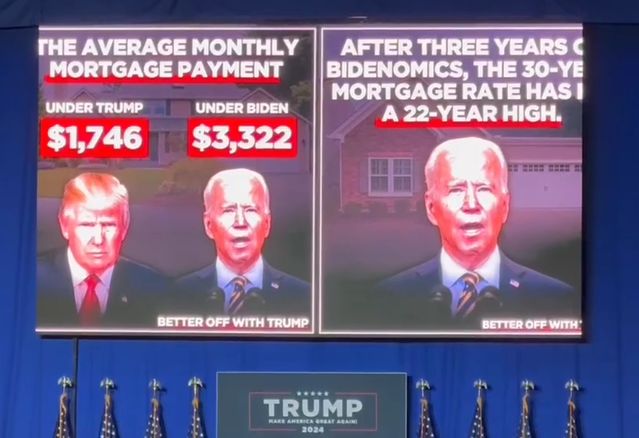Stand up for the facts!
Our only agenda is to publish the truth so you can be an informed participant in democracy.
We need your help.
I would like to contribute

Former President Donald Trump at a campaign rally in Durham, N.H., on Dec. 16, 2023. (AP)
Before former President Donald Trump spoke for 90 minutes in Durham, New Hampshire, his team compared Trump’s record with President Joe Biden’s record by projecting a series of statistics on the wall.
The images shown Dec. 16 had the tagline "Better off with Trump" and covered mortgage payments, mortgage rates and inflation.
Here’s a fact-check of three statements. The Trump campaign did not answer an inquiry for this article.
Some of the statistics cited on projections at Donald Trump’s rally Dec. 16, 2023, in Durham, N.H. (Rebecca Catalanello/PolitiFact)
This needs context.
Sign up for PolitiFact texts
The standard inflation measure, the consumer price index, has risen by 17.2% since January 2021, when Biden took office. That was an increase over three years, so the annual inflation rate was lower — about 5.9% per year during Biden’s presidency.
Rising wages have helped consumers manage some of this increase in prices.
A standard wage measure, average hourly earnings of all private-sector employees, has risen by 14% during Biden’s presidency, or about 4.8% per year. That means wages are still trailing inflation by about 1.1% a year, but it’s a smaller gap than Trump’s headline number.
The time frame for the calculation also matters.
As inflation has cooled over the past year, wage gains have narrowed the cumulative shortfall from inflation. Since November 2022, inflation has risen by 3.1%, but wages have risen by 4%. If the pattern holds, wage growth during Biden’s presidency may soon surpass the increase in prices.
Also, Americans are in a better place than they were on the eve of the coronavirus pandemic, which started during Trump’s last year in office. Since February 2020, the last full month before the pandemic hit, inflation has increased by 18.8%, while wages have increased by 19.4%.
This is Mostly True. Numerically, Trump is on target. However, Trump’s blaming Biden is less sound, economists said.
The 30-year fixed rate mortgage peaked at 7.79% on Oct. 26, 2023. That was the highest since the identical percentage on Nov. 10, 2000.
Mortgage rates have spiked because the Federal Reserve in March 2022 began raising interest rates to combat inflation. Fed interest rate hikes are considered the most effective economic tools for curbing inflation, because they tend to cool the economy, which eases demand and lowers prices.
Since the Fed hikes began, inflation has receded by about two-thirds. But a side effect has been that other types of interest rates — including mortgages — have also risen.
Since the mortgage rate peak in October, the average for a 30-year, fixed-rate mortgage has fallen, hitting 6.67% on Dec. 21. Not counting the peak in recent months, that’s still higher than any rate going back to Aug. 2, 2007, when the rate was 6.68%.
Economists generally agree that some of Biden’s policies likely added to the pressures that pushed up prices.
Biden’s coronavirus relief bill, the American Rescue Plan, put stimulus money into Americans’ hands when supply chains couldn’t produce enough goods to fulfill consumer demand. This worsened the rise of prices, which started because of pandemic-related supply-chain disruptions.
However, "the drivers of this inflation go back to COVID-19 — issues like supply-chain constraints, workforce shortages, and other factors," John Deskins, director of the West Virginia University Bureau of Business and Economic Research, told PolitiFact West Virginia in October. "That is much larger than any particular Biden policy."
Gary Burtless, an economist with the Brookings Institution, a Washington, D.C.-based think tank, said Biden should "assume some responsibility, but so should members of Congress who voted in favor of stimulus payments, tax cuts, generous unemployment benefits, aid to states and private businesses during and after the COVID-19 pandemic recession."
The American Rescue Plan got no Republican support in Congress, but earlier pandemic relief bills Trump signed were passed with bipartisan support.
This needs context.
These are the figures for average monthly payments on a new home, real estate company CBRE reports. That’s a significant out-of-pocket increase for someone buying a new home, but it doesn’t affect homeowners who aren’t looking to move.
The figure is calculated for the purchase of a new home valued at the U.S. median of $430,000, with a 10% down payment.
The majority of American mortgage holders have fixed-rate mortgages that were locked in at much lower rates. In 2022, about 85% of mortgages had fixed rates.
Given the current high rates, adjustable-rate mortgages are gaining popularity. If mortgage rates decrease in 2024, homeowners who hold adjustable-rate mortgages should see their payments drop.
A different calculation shows a lower average monthly mortgage payment. The most recent data from the Mortgage Bankers Association at the time of Trump’s statement showed that in October 2023, the national median mortgage payment for conventional loan applicants was $2,208.
Our Sources
Donald Trump, rally in Durham, N.H., Dec. 16, 2023
Federal Reserve Bank of St. Louis, consumer price index, accessed Dec. 20, 2023
Federal Reserve Bank of St. Louis, average hourly earnings of all private-sector employees, accessed Dec. 20, 2023
Federal Reserve Bank of St. Louis, 30-year fixed rate mortgage, accessed Dec. 20, 2023
Mortgage Bankers Association, "Mortgage Application Payments Increased 2.0 Percent to $2,199 in October," Nov. 30, 2023
Bloomberg, "The 30-Year Mortgage Is Saving the US Economy … or Is It?" June 27, 2023
New York Post, "Mortgage payments on a new home have risen 90% under Biden’s presidency," Dec. 13, 2023
PolitiFact, "Blame Joe Biden for inflation? Most government spending came earlier," July 29, 2021
PolitiFact West Virginia, "Fact-checking Shelley Moore Capito on high mortgage rates and their causes," Oct. 5, 2023



















































